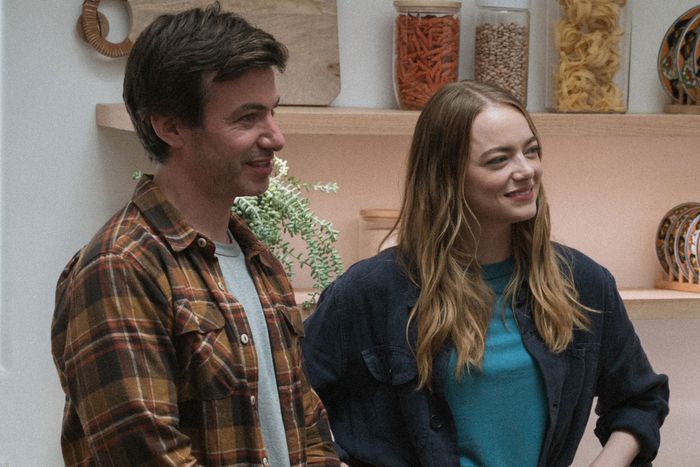
From the start, The Curse appears to be the ideal vehicle for its creators’ storytelling obsessions. Nathan Fielder and Benny Safdie’s Showtime drama stars Fielder and Emma Stone as Asher and Whitney Siegel, a couple desperate to sell their liberal-fantasy eco-conscious home-flipping scheme as a new series on HGTV, with Safdie playing their shameless producer. Whitney and Asher know they look like white saviors who want to reshape the New Mexico city of Española in the image they (mostly Whitney) think is best. Whitney tells herself and everyone she meets that she’s not like that. She’s not a slumlord like her parents. She knows her colonial history. She’s one of the good ones! The thematic layers continue: In the style of Chip and Joanna Gaines, Whitney and Asher try to present themselves and their happy marriage as an ideal to strive for; Whitney’s “passive” homes will support local businesses and turn Española into a haven for homeowners. The Curse then raises this highwire conceit. After Asher gives a young Black girl Nala (Hikmah Warsame) a $100 bill for the sake of good footage, then insists she give it back when the camera stops rolling, she appears to curse him. The whole world of the show opens up. Asher’s shaken. How much of what will come next is paranoia? How much is supernatural?
The promise of The Curse’s beginning comes from the heady rush of seeing all these ideas crammed together and imagining the strangeness that’s sure to come. Especially at the start, that overwhelming uneasiness is a testament to the show’s success rather than a failure. Stone’s performance in particular nails the skin-crawling sensation of watching someone who cannot stop thinking about how they’re being watched. Part of her seems to really want to be good, but she keeps measuring herself against what she sees as Asher’s flaws. He lacks intuitive compassion; she gets furious at him for holding a cell phone while handing someone a piece of Indigenous pottery. She wants to fix up a house for several thousand dollars; he immediately talks it down to a few hundred. Yet his cheapness and social miscues come across as inept but sincere; they’re genuine reflections of who Asher is. Whitney’s the one who can’t stop wondering how she’ll look on camera and adjusting herself until she’s confident in her own unimpeachable image. Safdie’s Dougie is every bit as off-putting as Whitney and Asher in his own distinctly oily way, needling Asher’s on-camera awkwardness and undermining his decisions while rolling his eyes at Whitney’s performative do-goodery. Asher insists he’s just pulling friendly pranks like when they were younger. A deeply sad history glimmers between these two characters, and Fielder and Safdie understand the power of forcing their characters — and the show’s viewers — to sit in the fallout of their choices rather than finding a swift resolution.
As they scramble to produce this reality show, Whitney and Asher must fake more and more of it to sustain interest. Whitney cherry-picks elements of Indigenous culture she thinks will look best on TV; she loves to give Native pottery to the home buyers (who are sometimes fictionalized for the show), but the pleasure of Native pottery is that it sits on a shelf, inanimate, a small piece of decorative art that she can take credit for and then manipulate however she wishes. Whitney maintains a tenuous, tense acquaintance with Cara (Nizhonniya Austin), a Picuris Pueblo artist whose work appears on the reality show without her permission. They keep dancing around the issue of her participation. Will Cara sign a release? What does she want in exchange? Cara and Whitney circling each other is one of the strongest elements of the series, especially as Cara becomes one of the few characters who seems to get under Whitney’s skin. After participating in Cara’s performance art at a gallery, Whitney can’t stop thinking about whether she did something wrong. She responds to the art in the same way she uses the rest of the community: by assuming it is mostly about her. Whitney longs for simple interpretations of how to fix her own colonial impulses and suspects Cara’s work has somehow demonstrated her ignorance. Whitney is so desperate for her approval; Cara is so patently disgusted by Whitney, and sometimes that disgust turns to pity. Stone and Austin play these scenes with beautiful, awful wariness.
Despite all this promising grist, ten hour-long episodes is a lot of time to sustain a creeping sense of doom, even if part of the point is that stewing in uncertainty and awkwardness can be a potent form of narrative tension. And although The Curse pulls it off in specific set pieces, the whole of it quickly starts to dawdle. The series hops unevenly between various plot threads — the curse, the TV production, the gentrification the couple refuses to call by its name, the strain on Whitney and Asher’s marriage, their ambivalence over conceiving a child, the fraying community support, a confusing and underdeveloped story involving Asher and a local casino. That shuffling, skipping structure from one idea to the next may well be intentional. It’s certainly off-putting, which is clearly what the show wants its audience to feel. If the aim is to create a series that can only be watched through your fingers, though, repeated story beats and uncovered secrets have to feel like they’re moving somewhere. There are so many little pieces of story to get snagged on, things that seem primed to add up to a big calamitous shock. Instead, The Curse keeps circling back on itself, defusing its bombs before they can explode and haphazardly lighting new ones that burn along merrily and then fizzle into a disappointing muted pop.
It can be fun to sit with a story that doesn’t necessarily go anywhere, but it doesn’t work when the minor characters lack the depth given to their central figures. Asher, Whitney, and Dougie have more than enough oddness to them, but their unnatural nerviness relies on their need to interact with normies, who set off and magnify their total inability to relax. If The Curse were one of Fielder’s previous works, those minor characters would have been real people playing themselves. In a docu-comedy, even when their portrayal is thin or fragmentary, the fact of their humanity is irreducible: They are full people with full lives, and part of the friction is being aware that some things are shown and some are edited out. But The Curse is fictional. They’re just minor characters, pure pieces of invention there to function in particular ways and then exit stage left. The Curse shows us small snapshots of Nala’s life and lingers on images of her face as she stares at Asher, implying that she has her own thoughts about him. We never see what they are, though, or what her father’s (Barkhad Abdi) life is like outside of Asher’s uncomfortable intrusion. The ex-con (Christopher Calderon) who works at the coffee shop Whitney and Asher built for HGTV creates a mess when he insists on bringing a gun to work … but who is he, beyond that role and that small development? Other than Cara, these characters lack the fictional development necessary to disguise their functionary roles. In a documentary or a reality show, they’d be striking peeks into the broader context that surrounds this produced version of real life. In The Curse, they look like standees propped around the town in judgmental poses, implying depth.
Even when it’s plodding, The Curse has a sharp visual language. Often the camera moves in ways that emphasize this is a TV show about a TV show, with a cold sense of distance from its central characters. Everyone’s being surveilled. The sound design echoes that sense of alarm: The score is full of buzzes and droning sounds, signaling wariness and mechanical inhumanity. At times Asher’s obsession with the curse feels justified. When he finds a pile of cooked chicken on a bathroom sink, a sign he connects to the curse, the shot of the chicken piled limp and gray on dirty porcelain is strange and awful enough to make the curse seem plausible.
Unfortunately, these qualities wear thin. The show leaves too many of its ideas undeveloped, especially from its central themes about race and constructions of the self. The Curse is fascinated by the way Whitney and Asher flatten this New Mexico community into a backdrop for their own issues, but it performs the same move, laying out an alluring framework of reality-show ethics and perpetual surveillance, then reducing them to a setting for a story about marriage. Whitney and Asher want to make a reality show about a community, but it’s unmistakably just about them. It tracks that this attempt to capture an intersectional multivocal tapestry of a place would ultimately narrow into a simpler, more solipsistic story about two people in a weird marriage. Even if that’s the thematic aim, though, it doesn’t do the circling, repetitive series any favors. It’s a show that loves to notice falseness, performance, incongruity, and anger, but like Whitney’s beloved Indigenous pottery, it’s content to let those observations just sit, aestheticized and inert.





